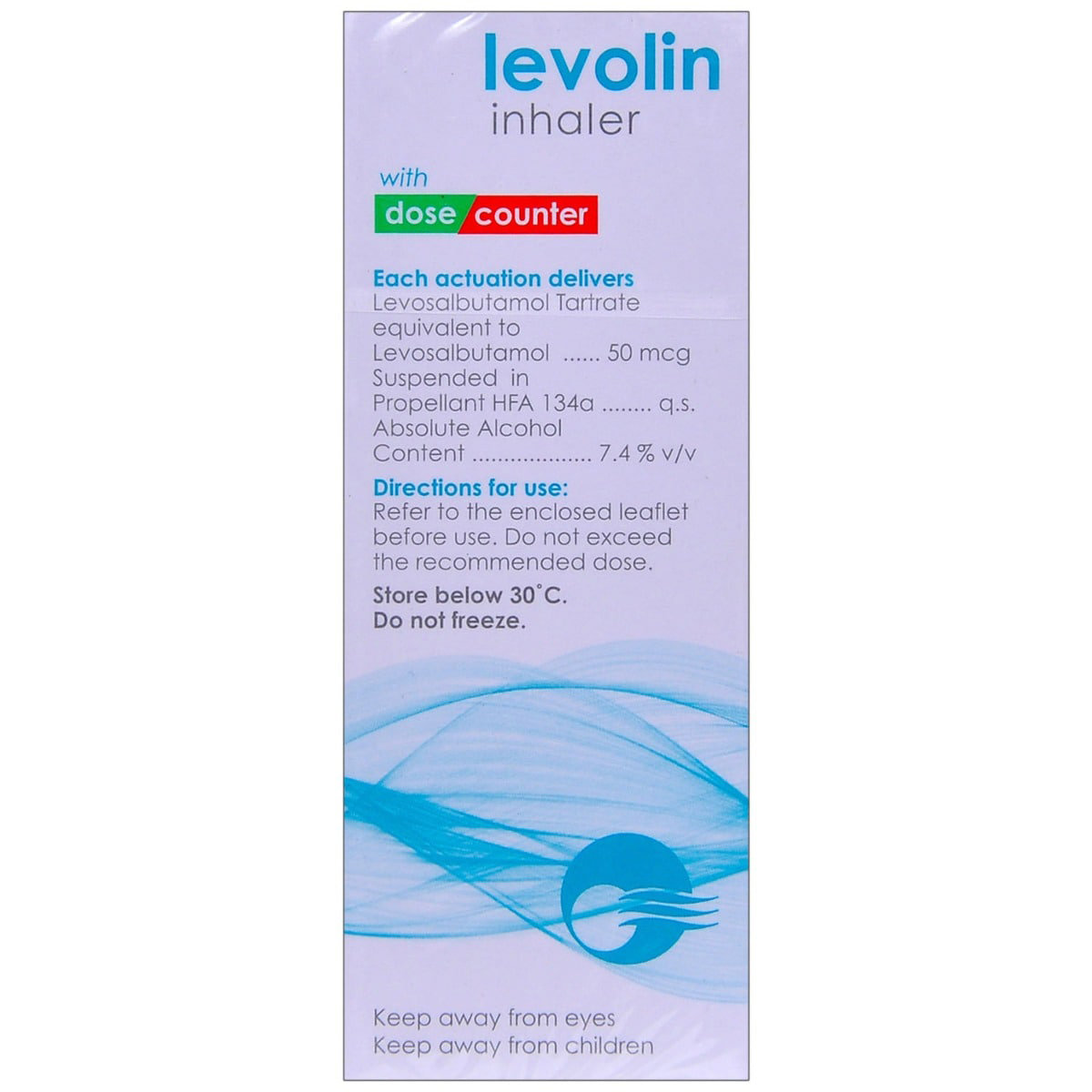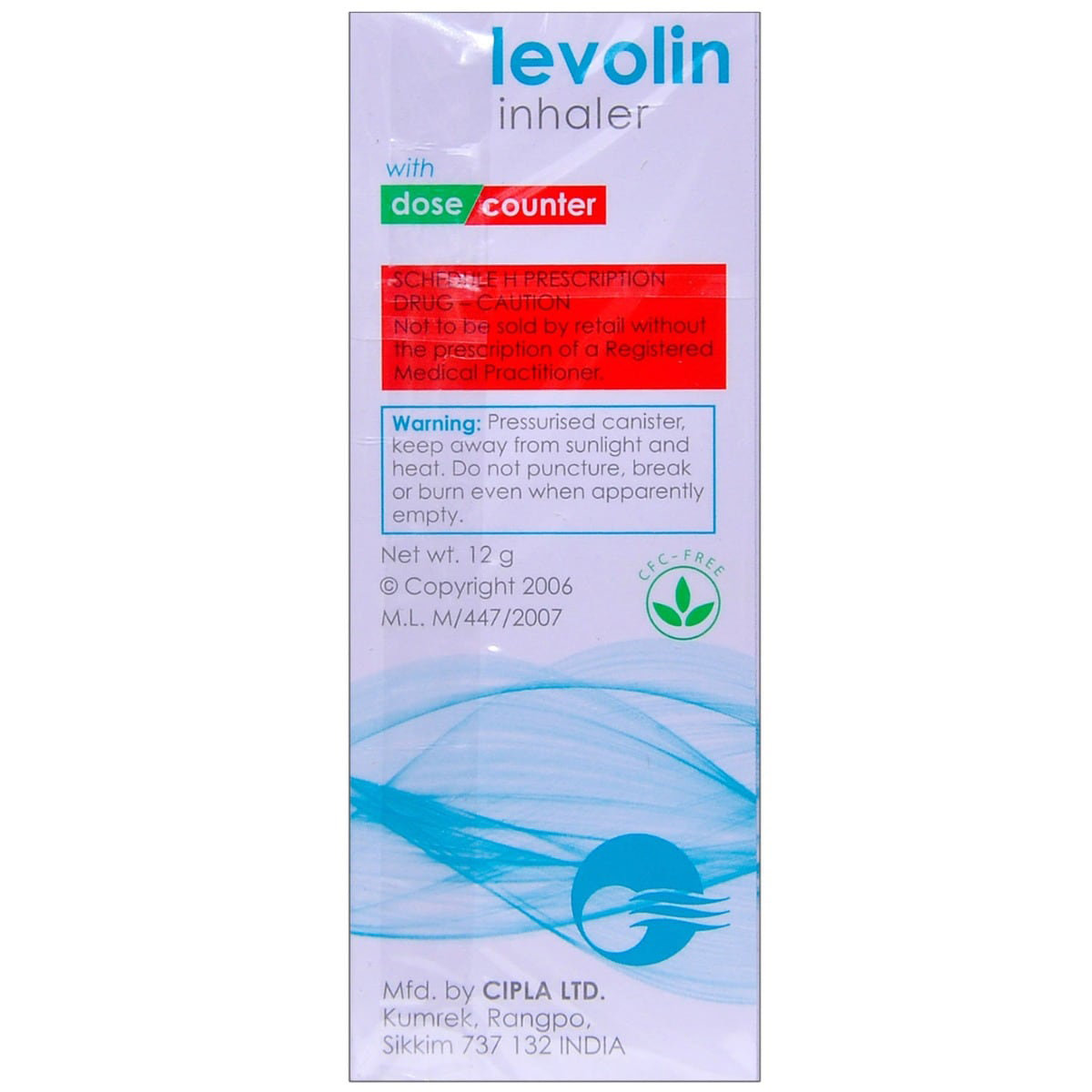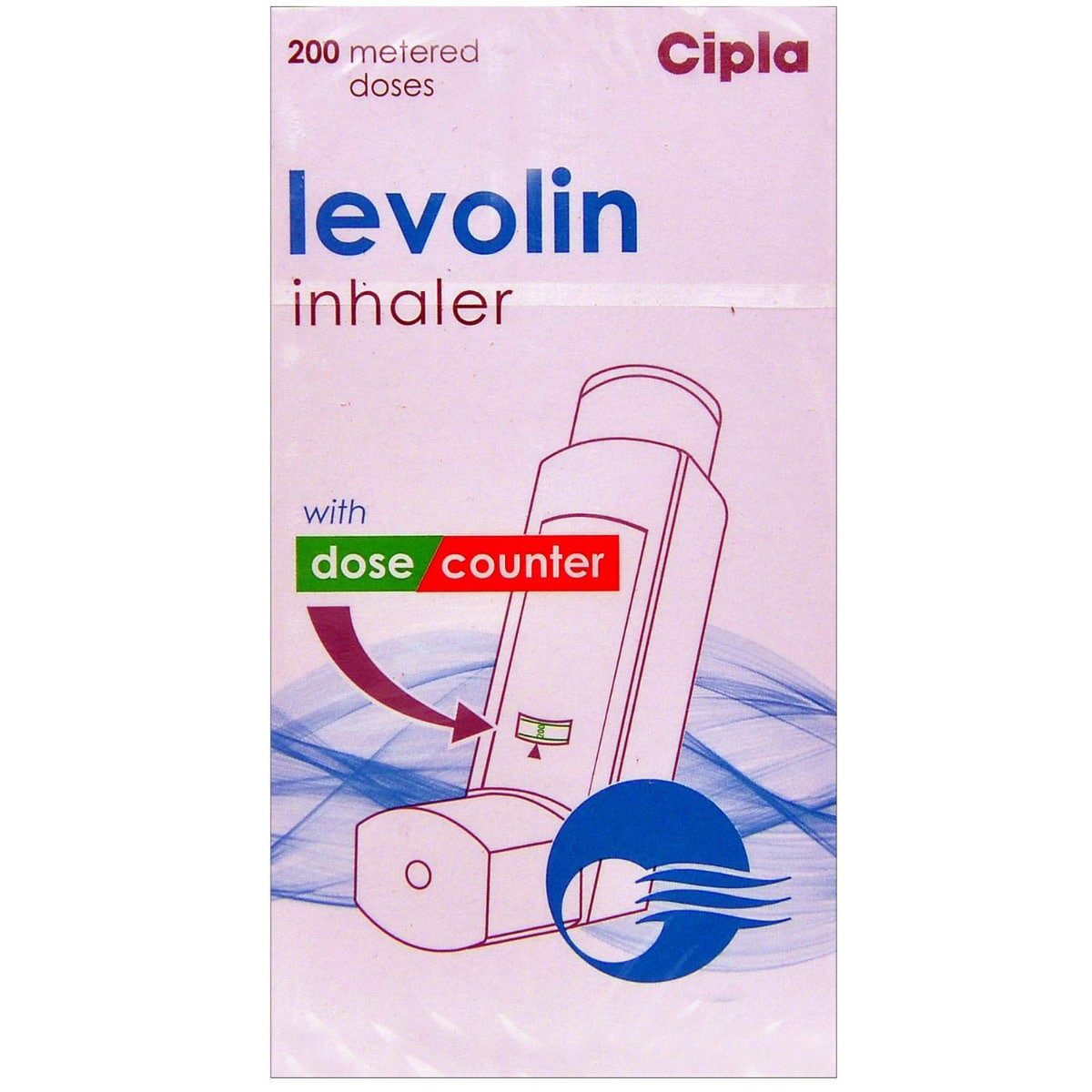Levolin Inhaler 200 mdi






MRP ₹264.5
(Inclusive of all Taxes)
₹39.7 Cashback (15%)
Provide Delivery Location
Online payment accepted
 Prescription drug
Prescription drugWhats That
Composition :
Manufacturer/Marketer :
Consume Type :
Expires on or after :
Return Policy :
About Levolin Inhaler 200 mdi
Levolin Inhaler 200 mdi belongs to the class of 'bronchodilators' primarily used to treat bronchospasm and symptoms of asthma and chronic obstructive pulmonary disease (COPD). Levolin Inhaler 200 mdi helps to relieve symptoms like coughing, wheezing and shortness of breath. Bronchospasm is the tightening of the muscles that line the airways or bronchi in the lungs. Asthma is a breathing problem in which airways narrow, swell and produce extra mucus, leading to difficulty breathing. COPD is a group of lung diseases with emphysema (shortness of breath) and chronic bronchitis (inflammation of the lining of the bronchial tubes).
Levolin Inhaler 200 mdi contains 'Levosalbutamol,' which is also known as levalbuterol. Levolin Inhaler 200 mdi is a bronchodilator that relaxes the muscles in the airways and increases airflow to the lungs. Levolin Inhaler 200 mdi thus makes breathing easier by widening the airways.
Your doctor will advise on how often you need to take Levolin Inhaler 200 mdi based on your medical condition. The common side effects of Levolin Inhaler 200 mdi include nausea, vomiting, restlessness, tremor (shakiness), headache, muscle tightness, dryness or soreness of the throat, dizziness, sleepiness, palpitations (irregular heartbeat), nasal congestion (stuffy nose), and increased heart rate. Most of these side effects of Levolin Inhaler 200 mdi do not require medical attention and gradually resolve over time. However, if the side effects are persistent, please seek medical help.
Try not to stop taking this medicine on your own. Brief your medical history to the doctor if you have any heart, liver, or kidney diseases, hyperthyroidism (overactive thyroid), stomach ulcer, seizure (fits), high blood pressure and diabetes before taking Levolin Inhaler 200 mdi. Please check with your doctor if you are pregnant, currently breastfeeding, or if you are taking any other prescribed or non-prescribed medicines. Avoid driving or operating machines since Levolin Inhaler 200 mdi may cause dizziness and drowsiness and affect your driving ability. Avoid drinking alcohol while taking Levolin Inhaler 200 mdi as it can worsen your sleepiness.
Uses of Levolin Inhaler 200 mdi
Directions for Use
Key Benefits
Levolin Inhaler 200 mdi contains 'Levosalbutamol,' which is also known as levalbuterol. Levolin Inhaler 200 mdi is used to treat bronchospasm and symptoms of asthma and chronic obstructive pulmonary disease (COPD), such as coughing, wheezing, and shortness of breath. It relaxes the muscles in the airways and increases airflow to the lungs. Levolin Inhaler 200 mdi makes breathing easier by widening the airways.
Storage
- Notify your doctor immediately if you experience tremors or involuntary shaking after taking medication or adjusting your medication regimen.
- Your doctor may adjust your medication regimen or recommend alternative techniques like relaxation, meditation, or journaling to alleviate tremor symptoms.
- Your doctor may direct you to practice stress-reducing techniques, such as deep breathing exercises, yoga, or journaling.
- Regular physical activity, such as walking or jogging, can help reduce anxiety and alleviate tremor symptoms.
- Your doctor may recommend lifestyle changes, such as avoiding caffeine, getting enough sleep, and staying hydrated, to help manage tremors.
- Maintain regular follow-up appointments with your doctor to monitor tremor symptoms and adjust treatment plans as needed.
- Tell your doctor immediately if you experience symptoms of Nervousness, such as anxiety, jitteriness, or an increased heart rate, after taking medication or adjusting your medication regimen.
- Your doctor may adjust your medication regimen to alleviate symptoms of Nervousness. This can include switching to a different medication, reducing the dosage, or temporarily stopping the medication. Your doctor may also recommend alternative techniques like relaxation, mindfulness meditation, or journaling. These techniques can help reduce anxiety and Nervousness.
- Practice stress-reducing techniques, such as deep breathing exercises, yoga, or journaling, to help manage Nervousness.
- Engage in regular physical activity, such as walking or jogging, to help reduce anxiety and improve mood.
- Your doctor may advise considering cognitive-behavioural therapy (CBT) or other forms of talk therapy to address underlying anxiety or Nervousness.
- You should maintain regular follow-up appointments with your doctor to monitor nervousness symptoms, adjust treatment plans as needed, and discuss any concerns or questions.
- Prepare for a restful night's sleep: Develop a calming pre-sleep routine, like reading or meditation, to help your body relax and prepare for sleep.
- Create a sleep-conducive Environment: Make bedroom a sleep haven by ensuring it is quiet, dark and calm.
- Follow a Sleep Schedule: Go to bed and get up at the same time every day to help regulate your body's internal clock and increase sleep quality.
- Try relaxing techniques like deep breathing, mindfulness meditation and any others.
- Limit stimulating activities before bedtime: Avoid stimulating activities before bedtime to improve sleep quality.
- Monitor Progress: Keep track of your sleep patterns to identify areas for improvement.
- Consult a doctor if needed: If these steps don't improve your sleep, consult a doctor for further guidance and therapy.
- Inform your doctor about the nausea and discuss possible alternatives to the medication or adjustments to the dosage.
- Divide your daily food intake into smaller, more frequent meals to reduce nausea.
- Opt for bland, easily digestible foods like crackers, toast, plain rice, bananas, and applesauce.
- Avoid certain foods that can trigger nausea, such as fatty, greasy, spicy, and smelly foods.
- Drink plenty of fluids, such as water, clear broth, or electrolyte-rich beverages like coconut water or sports drinks.
- Use ginger (tea, ale, or candies) to help relieve nausea.
- Get adequate rest and also avoid strenuous activities that can worsen nausea.
- Talk to your doctor about taking anti-nausea medication if your nausea is severe.
- Record when your nausea occurs, what triggers it, and what provides relief to help you identify patterns and manage your symptoms more effectively.
- Inform your doctor immediately if you experience a fever after starting a new medication.
- Your doctor may adjust your medication regimen or dosage as needed to minimize fever symptoms.
- Monitor your body temperature to monitor fever progression.
- Drink plenty of fluids, such as water or electrolyte-rich beverages, to help your body regulate temperature.
- Get plenty of rest and engage in relaxation techniques, such as deep breathing or meditation, to help manage fever symptoms.
- Under the guidance of your doctor, consider taking medication, such as acetaminophen or ibuprofen, to help reduce fever.
- If your fever is extremely high (over 103°F), or if you experience severe symptoms such as confusion, seizures, or difficulty breathing, seek immediate medical attention.
- Preventing Vomiting (Before it Happens)
- Take medication exactly as prescribed by your doctor. This can help minimize side effects, including vomiting.
- Having a small meal before taking your medication can help reduce nausea and vomiting.
- Talk to your doctor about taking anti-nausea medication along with your prescribed medication.
- Managing Vomiting (If it Happens)
- Try taking ginger in the form of tea, ale, or candy to help alleviate nausea and vomiting.
- What to Do if Vomiting Persists
- Consult your doctor if vomiting continues or worsens, consult the doctor for guidance on adjusting your medication or additional treatment.
- Hydrate your body: Drink enough water to prevent dehydration and headaches.
- Calm Your Mind: Deep breathing and meditation can help you relax and relieve stress.
- Rest and Recharge: Sleep for 7-8 hours to reduce headache triggers.
- Take rest: lie down in a quiet, dark environment.
- Cold or warm compresses can help reduce tension.
- Stay Upright: Maintain good posture to keep symptoms from getting worse.
- To treat headaches naturally, try acupuncture or massage therapy.
- Over-the-counter pain relievers include acetaminophen and ibuprofen.
- Prescription Assistance: Speak with your doctor about more substantial drug alternatives.
- Severe Headaches: Seek emergency medical assistance for sudden, severe headaches.
- Frequent Headaches: If you get reoccurring headaches, consult your doctor.
- Headaches with Symptoms: Seek medical attention if your headaches include fever, disorientation, or weakness.
Drug Warnings
Inform your doctor if you have any heart, liver or kidney diseases, hyperthyroidism (overactive thyroid), stomach ulcer, seizures (fits), high blood pressure, and diabetes before taking Levolin Inhaler 200 mdi. Levolin Inhaler 200 mdi may cause hypokalaemia (low potassium levels in the blood) in some patients leading to severe heart diseases, so Levolin Inhaler 200 mdi should be cautiously administered. Levolin Inhaler 200 mdi can cause a rise in blood glucose levels. Please monitor your blood glucose levels if you have diabetes and inform your doctor so that the dose can be adjusted accordingly. Also, let your doctor know if you plan to become pregnant, are already pregnant or if you are a lactating mother before starting Levolin Inhaler 200 mdi. Avoid driving or operating machines since Levolin Inhaler 200 mdi may cause dizziness and drowsiness and affect your driving ability. Avoid drinking alcohol as it can worsen your sleepiness and affect your mental ability when you are being treated with Levolin Inhaler 200 mdi.
Drug-Drug Interactions
Drug-Drug Interactions
Login/Sign Up
The combined use of Papaverine and Levolin Inhaler 200 mdi can increase the risk of an irregular heart rhythm which can be severe. The risk increases in patients with a history of heart illness or electrolyte imbalance.
How to manage the interaction:
Co-administration of Papaverine and Levolin Inhaler 200 mdi can lead to an interaction, it can be taken if advised by your doctor. However, if you experience any symptoms like dizziness, lightheadedness, fainting, shortness of breath, or heart palpitations, consult the doctor immediately. Do not stop using any medications without a doctor's advice.
Using propranolol and Levolin Inhaler 200 mdi together can reduce the effects or increase the risk of narrowing of the airways.
How to manage the interaction:
The combined use of propranolol and Levolin Inhaler 200 mdi can lead to an interaction, but they can be taken if advised by your doctor. However, if you experience any unusual symptoms contact your doctor immediately. Do not stop using any medications without first talking to your doctor.
Using pindolol and Levolin Inhaler 200 mdi together can increase the risk of narrowing of the airways.
How to manage the interaction:
The combined use of pindolol and Levolin Inhaler 200 mdi can lead to an interaction, it can be taken if advised by your doctor. However, if you experience Coughing, wheezing, shortness of breath, and high-pitched breathing, contact your doctor immediately. Do not discontinue any medications without consulting a doctor.
Co-administration of Levolin Inhaler 200 mdi with timolol can increase the risk of narrowing of the airways.
How to manage the interaction:
Although taking Levolin Inhaler 200 mdi and timolol together can possibly result in an interaction, it can be taken if your doctor has advised it. However, if you experience Coughing, wheezing, shortness of breath, and high-pitched breathing, contact your doctor immediately. Do not discontinue any medications without consulting a doctor.
Co-administration of Salbutaml with Labetalol, the effectiveness of Levolin Inhaler 200 mdi might be reduced.
How to manage the interaction:
Although taking Labetalol and Levolin Inhaler 200 mdi together can possibly result in an interaction, it can be taken if a doctor has prescribed it. Do not discontinue any medications without a doctor's advice.
Coadministration of Carvedilol and Levolin Inhaler 200 mdi may reduce the effects of both medications.
How to manage the interaction:
Although there is a possible interaction between Carvedilol and Levolin Inhaler 200 mdi, they can be taken if your doctor advises. Consult your doctor if you experience shortness of breath, chest pain or any difficulties in breathing. Do not stop using any medications without a doctor's advice.
Coadministration of mifepristone and Levolin Inhaler 200 mdi can increase the risk of an irregular heart rhythm which can be severe. The risk increases in patients with a history of heart illness or electrolyte imbalance.
How to manage the interaction:
Taking Levolin Inhaler 200 mdi with mifepristone together is avoided as it can result in an interaction, it can be taken if a doctor has advised it. However, contact a doctor immediately if you experience any symptoms such as dizziness, lightheadedness, fainting, shortness of breath, or irregular heartbeat. Do not discontinue any medications without consulting a doctor.
Coadministration of Penbutolol and Levolin Inhaler 200 mdi can reduce the effects of both medications and can cause narrowing of the airways.
How to manage the interaction:
Taking Penbutolol and Levolin Inhaler 200 mdi can lead to an interaction, it can be taken if advised by your doctor. However, if you experience Coughing, wheezing, shortness of breath, and high-pitched breathing, contact your doctor immediately. Do not discontinue any medications without consulting a doctor.
Using levobunolol and Levolin Inhaler 200 mdi together can reduce the benefits of both drugs and can cause narrowing of the airways.
How to manage the interaction:
The combined use of levobunolol and Levolin Inhaler 200 mdi can lead to an interaction, it can be taken if advised by your doctor. Don't forget to inform if you have any history of asthma, or severe chronic obstructive pulmonary disease (COPD), consult the doctor immediately. Do not stop using any medications without a doctor's advice.
Drug-Food Interactions
Drug-Food Interactions
Login/Sign Up
Diet & Lifestyle Advise
- Eat a healthy diet and exercise regularly to strengthen your breathing muscles and boost your immune system.
- Avoid foods such as cabbage, beans, garlic, onions, shrimp, pickled food, dried fruits, fried foods, carbonated drinks, wine, and bottled lemon and lime juice as it may worsen asthma symptoms.
- Do meditation, deep breathing, regular exercise and try progressive muscle relaxation techniques to get relief from stress and reduce the risk of an asthma attack.
- Quit smoking as it may reduce the effectiveness of Levolin Inhaler 200 mdi and irritate the lungs, worsening breathing problems.
- Learning breathing exercises will help you move more air in and out of your lungs.
Side Effects of Levolin Inhaler 200 mdi
- Nausea
- Vomiting
- Restlessness
- Tremor (shakiness)
- Headache
- Muscle tightness
- Dryness or soreness of the throat
- Dizziness
- Sleepiness
- Palpitations (irregular heartbeat)
- Nasal congestion (stuffy nose)
- Increased heart rate
Habit Forming
Therapeutic Class
All Substitutes & Brand Comparisons
Author Details
We provide you with authentic, trustworthy and relevant information
Drug-Diseases Interactions
Drug-Diseases Interactions
Login/Sign Up
FAQs
Levolin Inhaler 200 mdi works by relaxing the muscles in the airways and increasing airflow to the lungs.
Levolin Inhaler 200 mdi may cause central nervous system stimulation; hence Levolin Inhaler 200 mdi should be used cautiously if prescribed by the doctor for use in patients with seizures as it might worsen the condition.
Levolin Inhaler 200 mdi can cause a rise in blood glucose levels. Hence monitor your blood glucose levels if you have diabetes and inform your doctor so that the dose can be adjusted accordingly. Your diabetologist may adjust your insulin dose or prescribe alternate diabetic medication based on your condition.
You may experience headache and shakiness after using Levolin Inhaler 200 mdi. Drink plenty of water and take rest to manage your headache. Shakiness goes away gradually. Consult your doctor if these symptoms persist longer.
Levolin Inhaler 200 mdi can cause hypokalaemia in some patients leading to cardiovascular effects. Please consult your doctor before taking Levolin Inhaler 200 mdi if you are a hypokalaemia patient or are more susceptible to it.
Bronchodilators like Levolin Inhaler 200 mdi may cause rapid and irregular heartbeat, blood pressure changes and an electrocardiogram (ECG) changes. Please seek medical advice before using Levolin Inhaler 200 mdi if you are heart disease patient.
Bronchodilators like Levolin Inhaler 200 mdi should be cautiously used only under a doctor's supervision if you have any heart, liver, kidney diseases, hypokalaemia, hyperthyroidism (overactive thyroid), stomach ulcer, seizure (fits), high blood pressure, and diabetes.
Drug-Drug Interactions Checker List
- FUROSEMIDE
- DIGOXIN
- PREDNISONE
- FLUTICASONE
- BUDESONIDE
- SALMETEROL
- VILANTEROL
- FORMOTEROL
- ALBUTEROL
- ONDANSETRON
Special Advise
- Monitor your blood glucose levels regularly since Levolin Inhaler 200 mdi can raise blood sugar levels.
- Keep a check on your heart condition (if you are a heart disease patient) with an ECG if you notice any rapid heartbeat and blood pressure changes.
- Undergoing a blood examination for your potassium levels in the blood will help rule out the possibility of hypokalaemia.
Disease/Condition Glossary
Bronchospasm: It is the tightening of the muscles that line the airways or bronchi in the lungs. Symptoms include wheezing, chest pain, tightness in the chest, and fatigue.
Asthma: It is a chronic (long-term) respiratory condition in which airways narrow, swell, and produce extra mucus, leading to difficulty in breathing. The symptoms of asthma include wheezing (whistling sound while breathing), shortness of breath, chest tightness, and cough, especially at night. The symptoms of mild persistent asthma may occur more than 2 times a week and up to 4 nights in a month, whereas, in the case of severe persistent asthma, the symptoms occur several times every day and most nights. The treatment for asthma includes medication, breathing exercises, and self-care.
Chronic obstructive pulmonary disease (COPD): It is a group of lung diseases with emphysema (shortness of breath) and chronic bronchitis (inflammation of the lining of bronchial tubes). The major cause of COPD is smoking tobacco. Also, long-term exposure to fumes and chemicals may also lead to COPD. The symptoms include chronic cough, shortness of breath, or wheezing (whistle sound while breathing).

Have a query?
Buy best Respiratory System products by
Cipla Ltd
Lupin Ltd
Glenmark Pharmaceuticals Ltd
Sun Pharmaceutical Industries Ltd
Alkem Laboratories Ltd
Macleods Pharmaceuticals Ltd
Mankind Pharma Pvt Ltd
Zydus Healthcare Ltd
Leeford Healthcare Ltd
Dr Reddy's Laboratories Ltd
Zydus Cadila
Abbott India Ltd
Intas Pharmaceuticals Ltd
Alembic Pharmaceuticals Ltd
German Remedies Ltd
Centaur Pharmaceuticals Pvt Ltd
Ipca Laboratories Ltd
Aristo Pharmaceuticals Pvt Ltd
Pristine Pearl Pharma Pvt Ltd
Wockhardt Ltd
GlaxoSmithKline Pharmaceuticals Ltd
Zuventus Healthcare Ltd
Koye Pharmaceuticals Pvt Ltd
Micro Labs Ltd
Blue Cross Laboratories Pvt Ltd
Medishri Healthcare Pvt Ltd
Med Manor Organics Pvt Ltd
Indiabulls Pharmaceuticals Pvt Ltd
Adonis Laboratories Pvt Ltd
FDC Ltd
Fourrts India Laboratories Pvt Ltd
Tablets India Ltd
J B Chemicals & Pharmaceuticals Ltd
Shreya Life Sciences Pvt Ltd
Divine Savior Pvt Ltd
Indoco Remedies Ltd
Seagull Pharmaceutical Pvt Ltd
Yash Pharma Laboratories Pvt Ltd
Torque Pharmaceuticals Pvt Ltd
Uniza Healthcare Llp
Wings Pharmacuticals Pvt Ltd
Biological E Ltd
Corona Remedies Pvt Ltd
Icarus Health Care Pvt Ltd
Steris Healthcare
Apex Laboratories Pvt Ltd
Geno Pharmaceuticals Pvt Ltd
Navil Laboratories Pvt Ltd
Precept Pharma
Aar Ess Remedies Pvt Ltd
La Renon Healthcare Pvt Ltd
Torrent Pharmaceuticals Ltd
Astra Zeneca Pharma India Ltd
Biochem Pharmaceutical Industries Ltd
Comed Chemicals Ltd
Entod Pharmaceuticals Ltd
Franco Indian Pharmaceuticals Pvt Ltd
Healthgate Pvt Ltd
Intra Life Pvt Ltd
Megma Healthcare Pvt Ltd
Pfizer Ltd
RPG Life Sciences Ltd
Unipark Biotech Pvt Ltd
Votary Laboratories (India) Ltd
Wanbury Ltd
Brinton Pharmaceuticals Ltd
Dolvis Bio Pharma Pvt Ltd
Eisen Pharmaceutical Co Pvt Ltd
Group Pharmaceuticals Ltd
Knoll Pharmaceuticals Ltd
Morepen Laboratories Ltd
Panacea Biotec Ltd
Prevego Healthcare & Research Pvt Ltd
Rnd Laboratories Pvt Ltd
Sanatra Healthcare Ltd
Skn Organics Pvt Ltd
Stedman Pharmaceuticals Pvt Ltd
Thuyam Life Pvt Ltd
Timon Pharmaceuticals Pvt Ltd
Aglowmed Pharmaceuticals Ltd
Ajanta Pharma Ltd
Alniche Life Sciences Pvt Ltd
Bio Warriors Pharmaceucticals Pvt Ltd
Biochemix Health Care Pvt Ltd
Cadila Healthcare Ltd
Cadila Pharmaceuticals Ltd
Caplet India Pvt Ltd
Chemo Healthcare Pvt Ltd
Delcure Life Sciences Ltd
East West Pharma India Pvt Ltd
Elder Pharmaceuticals Ltd
Embiotic Laboratories (P) Ltd
Emcee Pharmaceuticals (P) Ltd
Foregen Healthcare Ltd
Hetero Healthcare Pvt Ltd
Incite Pharmaceuticals
Iva Healthcare Pvt Ltd
Kepler Healthcare Pvt Ltd
Kristal Pharmaceuticals
Lincoln Pharmaceuticals Ltd
Alcohol
Safe if prescribed
Avoid drinking alcohol while taking Levolin Inhaler 200 mdi as it can worsen your sleepiness/dizziness.
Pregnancy
Consult your doctor
The safety of Levolin Inhaler 200 mdi in pregnant women is unknown. Please consult your doctor if you are planning to become pregnant or already pregnant before starting Levolin Inhaler 200 mdi.
Breast Feeding
Consult your doctor
There is limited data on how Levolin Inhaler 200 mdi affects breastfeeding. Please consult your doctor before starting Levolin Inhaler 200 mdi.
Driving
Safe if prescribed
Do not drive or operate machinery if you experience drowsiness, increased/uneven heart rate and shakiness while using Levolin Inhaler 200 mdi. This may affect your ability to drive. Seek medical attention if the symptoms persist longer.
Liver
Consult your doctor
Levolin Inhaler 200 mdi should be used with caution in patients with liver diseases. Let your doctor know if you have any history of liver diseases or hepatic impairment. Your doctor will weigh the benefits and potential risks before prescribing Levolin Inhaler 200 mdi.
Kidney
Consult your doctor
Levolin Inhaler 200 mdi should be used with caution in patients with kidney diseases. Let your doctor know if you have any history of kidney diseases. Your doctor will weigh the benefits and potential risks before prescribing Levolin Inhaler 200 mdi.
Children
Safe if prescribed
Levolin Inhaler 200 mdi is recommended for children only with a doctor's advice. The dose may have to be adjusted by your doctor depending upon the child's condition and age.





